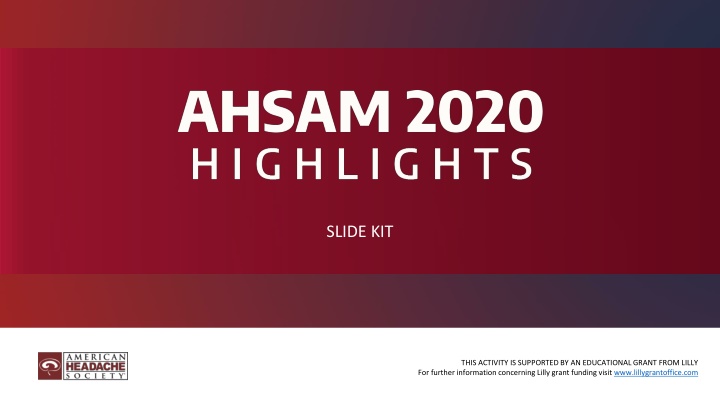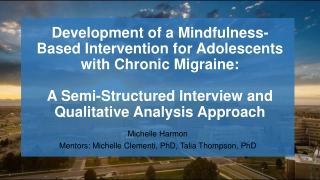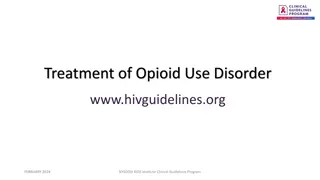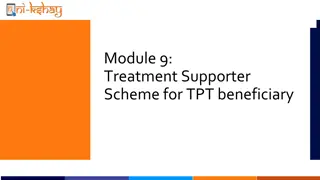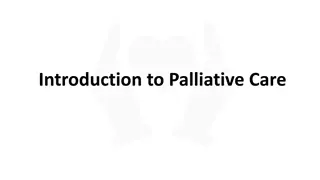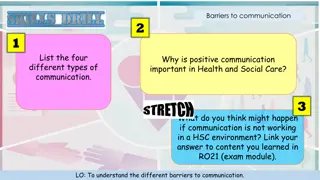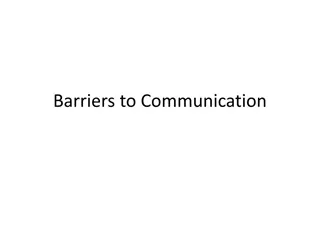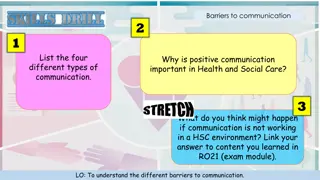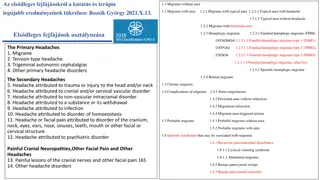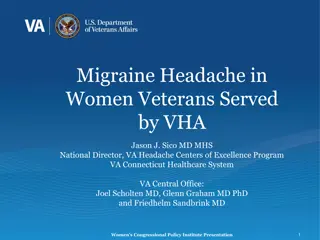Identifying Barriers to Care in Migraine Treatment
Results of the OVERCOME Study led by Sait Ashina, MD reveal insights into barriers in seeking care, diagnosis, and preventive medication for migraine sufferers. The study highlights factors influencing effective treatment paths and emphasizes the importance of consulting healthcare professionals for optimal outcomes.
Download Presentation

Please find below an Image/Link to download the presentation.
The content on the website is provided AS IS for your information and personal use only. It may not be sold, licensed, or shared on other websites without obtaining consent from the author.If you encounter any issues during the download, it is possible that the publisher has removed the file from their server.
You are allowed to download the files provided on this website for personal or commercial use, subject to the condition that they are used lawfully. All files are the property of their respective owners.
The content on the website is provided AS IS for your information and personal use only. It may not be sold, licensed, or shared on other websites without obtaining consent from the author.
E N D
Presentation Transcript
SLIDE KIT THIS ACTIVITY IS SUPPORTED BY AN EDUCATIONAL GRANT FROM LILLY For further information concerning Lilly grant funding visit www.lillygrantoffice.com
SLIDE KIT Identifying Barriers to Care Identifying Barriers to Care- -seeking, Diagnosis, and Preventive seeking, Diagnosis, and Preventive Medication Among Those with Migraine: Results of the Medication Among Those with Migraine: Results of the OVERCOME Study OVERCOME Study Presented by Sait Ashina, MD Assistant Professor of Neurology and Anesthesia Harvard Medical School, Beth Israel Deaconess Medical Center, Boston, Massachusetts Developed by Infomedica Medical Education& Information AHS Virtual Annual Scientific Meeting content is made available to an international audience through a licensing agreement between Infomedica and the American Headache Society. Infomedica is an independent medical education provider that delivers medical information to healthcare professionals through conference coverage and online educational programs and activities.
A M E R I C A N H E A D A C H E S O C I E T Y V I R T U A L A N N U A L S C I E N T I F I C M E E T I N G O F F I C I A L H I G H L I G H T S Key messages There are three conditional steps to effective preventative migraine treatment: consulting a healthcare professional, receiving an accurate diagnosis and taking a recommended preventative medication.1,2 Only 15.4% with disabling migraine traversed these steps. A higher likelihood of traversing the steps was associated with older age, having health insurance, higher migraine frequency, more severe migraine-related disability, pain severity, cutaneous allodynia, poor acute treatment optimization and care sought at a specialist. A lower likelihood of traversing the steps was associated with seeking care at an Emergency Department, Urgent Care or Retail Clinic. DEVELOPED BY
A M E R I C A N H E A D A C H E S O C I E T Y V I R T U A L A N N U A L S C I E N T I F I C M E E T I N G O F F I C I A L H I G H L I G H T S Background What do we already know about this topic? Understanding the patient s path to taking recommended preventative migraine medication may help identify barriers to effective treatment. Previous studies have not considered episodic and chronic migraine together and took place in a historical healthcare environment.3,4 The observational survey of the epidemiology, treatment and care of migraine (OVERCOME) was a web-based survey providing a contemporary view of the migraine healthcare landscape, considering both episodic and chronic migraine. DEVELOPED BY
A M E R I C A N H E A D A C H E S O C I E T Y V I R T U A L A N N U A L S C I E N T I F I C M E E T I N G O F F I C I A L H I G H L I G H T S Background How was this study conducted? Subgroup analysis of adult patients from the OVERCOME study with moderate or severe migraine-associated disability (n=5,873), validated by AMS/AMPP diagnostic screener or self-report healthcare provider (HCP) diagnosis.5 Subgroups were based upon whether patients sought care over the past 12 months, migraine diagnosis by a HCP, and taking recommended preventative treatment, with data stratified by monthly headache days category: 4 7, 8 14, 15 days. Considered measurements of migraine disability, cutaneous allodynia, symptom severity, treatment optimization, quality of life related to migraine, and pain severity. 6,7,8,9 DEVELOPED BY
A M E R I C A N H E A D A C H E S O C I E T Y V I R T U A L A N N U A L S C I E N T I F I C M E E T I N G O F F I C I A L H I G H L I G H T S Findings What does this study add? 69% sought care, and of those 80% were diagnosed and 28.3% subsequently received recommended preventative treatment. Only 15.4% of individuals with 4 monthly headache days and moderate or severe headache-related disability, followed the pathway: sought care, diagnosed and take recommended preventative treatment. Seeking care was associated with older age males, having health insurance and severe headache disability, while migraine diagnosis was associated with being female and having severe headache disability. Receiving recommended preventative medication was associated with having health insurance and severe headache disability. Notably, seeking care exclusively at an Emergency Department/Urgent Care/Retail Clinic was associated with lack of diagnosis and not receiving recommended preventative treatments. DEVELOPED BY
A M E R I C A N H E A D A C H E S O C I E T Y V I R T U A L A N N U A L S C I E N T I F I C M E E T I N G O F F I C I A L H I G H L I G H T S Perspectives How does this study impact clinical practice? There are a large number of barriers but opportunities are available to improve the diagnosis and management of disabling migraine given the current availability of preventative therapies. Patients seeking care exclusively at Emergency Departments, Urgent Care and Retail Clinics need to be referred to a HCP to receive a full diagnosis and effective preventative treatments. DEVELOPED BY
A M E R I C A N H E A D A C H E S O C I E T Y V I R T U A L A N N U A L S C I E N T I F I C M E E T I N G O F F I C I A L H I G H L I G H T S References 1. Silberstein SD, Holland S, Freitag F, et al. Evidence-based guideline update: pharmacologic treatment for episodic migraine prevention in adults: report of the Quality Standards Subcommittee of the American Academy of Neurology and the American Headache Society. Neurology 2012;78:1337-1345. American Headache Society. The American Headache Society Position Statement On Integrating New Migraine Treatments Into Clinical Practice. Headache 2019;59:1-18. Dodick DW, Loder EW, Manack Adams A, et al. Assessing Barriers to Chronic Migraine Consultation, Diagnosis, and Treatment: Results From the Chronic Migraine Epidemiology and Outcomes (CaMEO) Study. Headache 2016;56:821-834. Lipton RB, Serrano D, Holland S, et al. Barriers to the diagnosis and treatment of migraine: effects of sex, income, and headache features. Headache 2013;53:81-92. Lipton RB, Stewart WF, Diamond S, et al. Prevalence and burden of migraine in the United States: data from the American Migraine Study II. Headache 2001;41:646-657. Stewart WF, Lipton RB, Dowson AJ, et al. Development and testing of the Migraine Disability Assessment (MIDAS) Questionnaire to assess headache-related disability. Neurology 2001;56(Suppl 1):S20-S28. Lipton RB, Bigal ME, Ashina S, et al. Cutaneous allodynia in the migraine population. Annals of Neurology 2008;63:148- 158. Lipton RB, Kolodner K, Bigal ME, et al. Validity and reliability of the Migraine-Treatment Optimization Questionnaire. Cephalalgia 2009;29:751-759. Martin BC, Pathak DS, Sharfman MI, et al. Validity and reliability of the migraine-specific quality of life questionnaire (MSQ Version 2.1). Headache 2000;40:204-215. 2. 3. 4. 5. 6. 7. 8. 9. DEVELOPED BY
